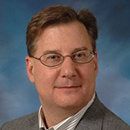January 2015

Thomas Ferkol, MD
With early registration open and full registration just weeks away, excitement is building for the ATS 2015 International Conference in Denver. The International Conference Committee has planned more than 500 clinical and research sessions, and speakers from around the world will present nearly 6,000 abstracts and case reports at ATS 2015, which will recognize the Society’s 110th anniversary. The five-day conference, which is expected to draw nearly 14,000 investigators, educators, and clinicians, is truly the destination for pulmonary, critical care, and sleep professionals at every level of their careers.
Consider those numbers for a moment and you’ll quickly realize how the International Conference has grown and become all-encompassing. Those of us accustomed to meetings of this size feel like kids in a candy store as we begin to plan our activities during the conference. Early career professionals and fellows, on the other hand, may feel a little overwhelmed.
I remember myself as an early career professional at my first ATS International Conference, which was in 1995 in Seattle. Each October, I would attend the North American Cystic Fibrosis Conference, primarily because my research focused on the pulmonary complications of cystic fibrosis. That year, for some reason, I was unable to attend the North American Cystic Fibrosis Conference, so I went to the ATS International Conference instead.
It was truly a revelation. The conference was massive and at times confusing. There were so many sessions I could potentially attend, that I ended up running myself ragged—actually jogging up city streets and hotel halls to catch one speaker, and sprinting back down to catch another. I don’t think I was ever so tired at a conference as I was at my first ATS conference. I tried to drink it all in, but quickly discovered that my approach was wholly inefficient.
Fortunately for early career professionals now, we have come a long way in providing support to the first-time attendees. The Members In-Transition and Training Committee has offered the Road Map for Trainees and Early Career Professionals, a pocket guide that highlights core sessions and events that makes the conference easier to navigate for trainees and first-time attendees. We anticipate its release by March.
As the lead story in this issue of ATS News reports, we will again offer education programs to ensure the success of our younger colleague at the conference and beyond, such as the Fellows Track Symposium, a two-day course for 150 clinical fellows in pulmonary, critical care, and sleep medicine. The Resident Boot Camp, a two-day course for internal medicine and pediatric residents who have matched into adult and pediatric pulmonary and critical care fellowships, was a huge success last year, and we have expanded the program. The popular Student Scholar Program connects students with mentors and gives them a deeper glimpse into our fields.
Our younger attendees can meet their peers and gain advice from senior professionals during the Networking Exchange for Early Career Professionals that immediately follows the Opening Ceremony. In addition, they can receive career guidance through the workshops held at the Center for Career Development, the Faculty Development Series, or the new comprehensive postgraduate course “Key Skills for a Successful Career in Academic Medicine,” which is featured in this issue. Like previous years, the Society will provide additional funding to talented individuals through the Minority Trainee Development Scholarship and Ziskind Clinical Research Scholar Award programs.
So, while the conference has grown, so too have the programs to guarantee that all attendees have the best experiences possible. I encourage you to see what will be available in Denver at the ATS 2015 website, and share this information with your colleagues. I do look forward to seeing you in May.

